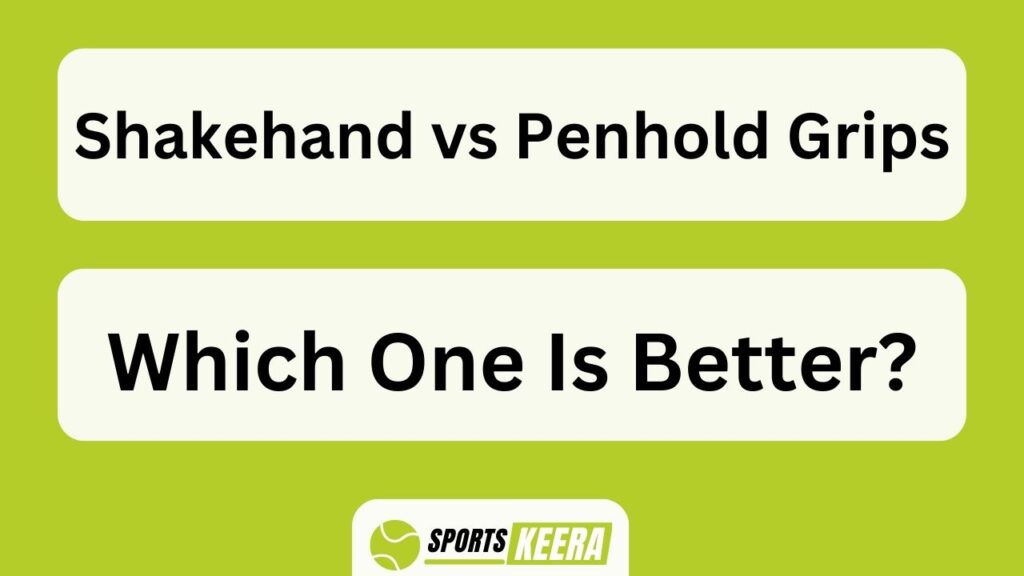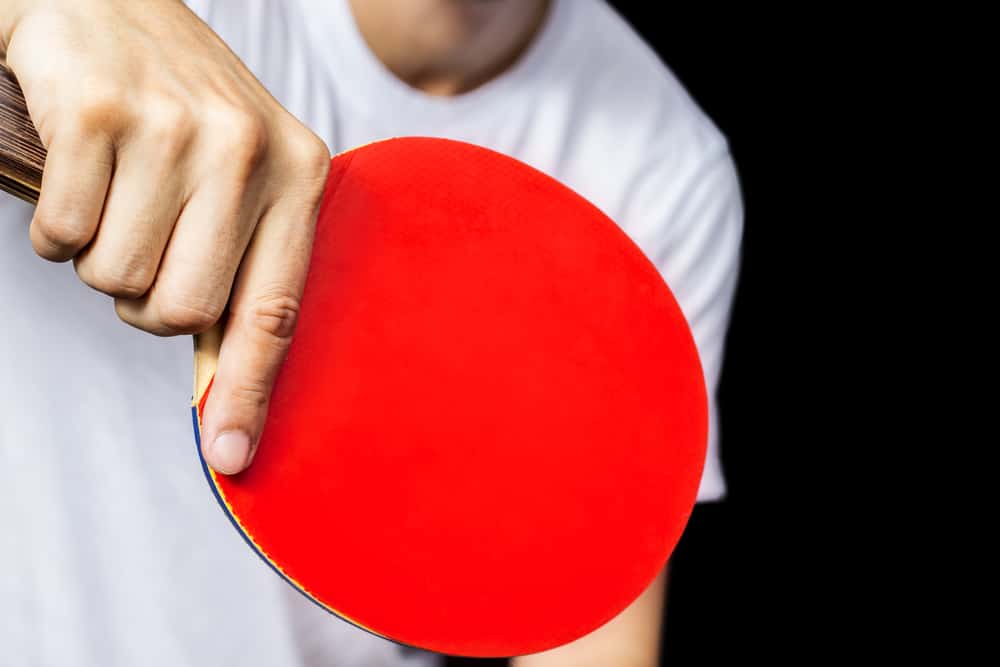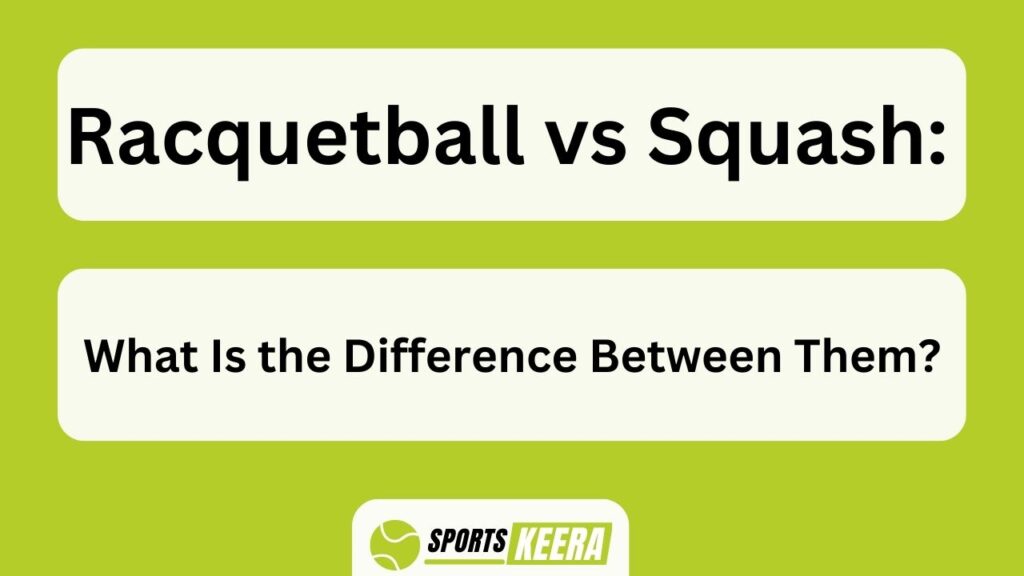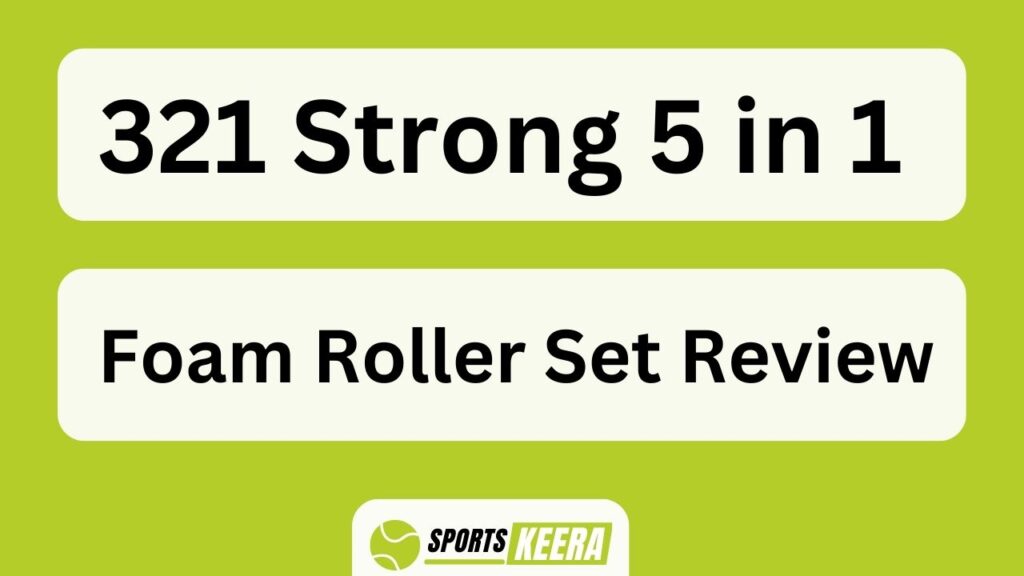Imagine a fierce battle on the table tennis court, where two opponents stand poised with rackets in hand. Their grips, like the strokes they wield, differ greatly – one holds their racket in a handshake grip, while the other opts for the penhold grip. Just as each player wields their weapon of choice differently, these two grips offer distinct advantages and disadvantages.
In this article, we will delve into the world of shakehand and penhold grips to determine which is better suited for table tennis enthusiasts seeking ultimate control, power, spin, and adaptability. The shakehand grip, with its firm grasp resembling a confident handshake, offers stability and precision in every stroke. On the other hand (pun intended), the penhold grip’s unique hold resembles that of holding a pen or chopsticks—providing players with agility and versatility.
Throughout this article, we will explore various aspects such as control and precision, power and speed capabilities, spin and serve techniques, as well as how professional players choose their grip style. So whether you’re a seasoned player looking to improve your game or an aspiring enthusiast ready to embark on your table tennis journey—we’ve got you covered!
Join us as we uncover the secrets behind these gripping techniques and help you decide which one reigns supreme: shakehand or penhold?
Key Takeaways of Shakehand Vs Penhold Grips: Which One Is Better?
- Shakehand grip offers stability, precision, and better reach for forehand strokes, while Penhold grip provides agility, versatility, and better maneuverability for quick changes in direction.
- Shakehand grip allows for more power and control in shots, while Penhold grip offers better control over the paddle and more precise placement and angles in attacking shots.
- Shakehand grip provides better accuracy for short and controlled shots, while Penhold grip offers finesse, agility, better manipulation of spin and placement, and a wider range of shot options.
- Choosing between the two grips depends on personal preference, playing style, hand size, flexibility, and experience. Experimenting with both grips during practice sessions is recommended to determine the best choice.
Overview of Shakehand Grip
You’ll find that the shakehand grip is widely embraced by players due to its versatility and comfortable feel. This grip involves holding the racket like you would a handshake, with the thumb on one side of the handle and the other fingers wrapped around it.
One of the main advantages of this grip is that it allows for more power and control in shots because of its stability. It also provides better reach for forehand strokes and gives players more options when it comes to spin variations.
However, there are some disadvantages to using the shakehand grip as well. It can be less effective for backhand shots, especially when it comes to generating power and accuracy. Additionally, it may take longer to master compared to other grips.
Now let’s move on to an overview of the penhold grip…
Overview of Penhold Grip
Interestingly, there’s a unique and distinctive grip known as the penhold grip that offers players a different approach to their game. This grip involves holding the racket with the thumb and index finger on one side, while the other fingers are kept curved around the handle.
When it comes to finger positioning, the penhold grip allows for more control over the paddle due to its close proximity to the blade. This enables players to generate powerful shots with greater ease. Additionally, this grip provides better maneuverability for quick changes in direction during rallies.
However, there are some disadvantages to using the penhold grip as well. One major drawback is limited backhand technique and reduced reach compared to shakehand grip. The restricted finger placement can make it challenging for players to execute effective backhand shots.
While the penhold grip offers advantages such as enhanced control and maneuverability, it also comes with limitations in terms of backhand technique and reach. These factors need to be considered when comparing its overall effectiveness against the shakehand grip in terms of control and precision in table tennis gameplay.
Comparison of Control and Precision
When comparing the control and precision of the shakehand grip versus the penhold grip in table tennis, there are some key points to consider.
With the shakehand grip, we have a more stable hold on the racket, allowing for better control over our shots. On the other hand, the penhold grip offers a unique advantage with its ability to generate greater power due to its wrist flexibility.
Additionally, when it comes to precision, both grips have their own strengths – while the shakehand grip provides better accuracy for short and controlled shots, the penhold grip allows for more precise placement and angles in attacking shots.
Control with the shakehand grip
Sure, gripping the paddle with the shakehand style allows you to have total control over your shots and ensures that your opponents will tremble in fear at your impeccable accuracy.
With the shakehand grip, you can strike a perfect balance between precision and power. The position of the fingers on the backside of the racket gives you excellent finger control, allowing for subtle adjustments in your strokes. This level of control enables you to place the ball exactly where you want it on the table, making it difficult for your opponent to return.
Additionally, having a firm grip on the handle enhances stability and minimizes errors caused by unwanted movements. However, while the shakehand grip offers exceptional control, let’s explore how control with the penhold grip compares.
Control with the penhold grip
Control with the penhold grip provides a unique blend of finesse and agility, allowing for swift and precise movements on the table. The advantages of the penhold grip over the shakehand grip are numerous. Firstly, with the penhold grip, players have greater control over their shots due to the ability to hold the paddle more securely with fingers on both sides. This allows for better manipulation of spin and placement, giving players an edge in their game strategy.
Additionally, the penhold grip offers a wider range of shot options, including powerful forehand drives and deceptive backhand flips. On the other hand, one disadvantage of the shakehand grip is that it can limit wrist flexibility and restrict certain shots. Consequently, players using this grip may struggle to generate as much spin or vary their shots as effectively as those using a penhold grip.
Transitioning into precision with each grip requires understanding their respective strengths and weaknesses in order to make informed decisions during gameplay.
Precision with each grip
Mastering the different grips requires players to develop a delicate touch, like a conductor guiding an orchestra with precise movements of their fingers.
When it comes to precision control, both the shakehand and penhold grips have their strengths. With the shakehand grip, players have more contact points on the racket, allowing for better control over the ball’s spin and direction. On the other hand, the penhold grip offers a unique advantage in precision control by enabling players to make subtle adjustments with their fingers’ positioning on the paddle. This allows for fine-tuning shots and executing precise placements with accuracy.
Additionally, both grips require proper technique and practice to generate power effectively. Transitioning into the subsequent section about power and speed comparison, let’s explore how each grip influences these aspects of gameplay.
Power and Speed Comparison
When discussing power generation with the shakehand grip, it’s important to note that this grip allows for a strong and stable foundation. The handshake grip enables players to generate more power in their shots by utilizing the larger muscles in their arm and shoulder.
On the other hand, power generation with the penhold grip is focused on wrist and finger movements, allowing for quick and explosive shots. Additionally, when it comes to speed advantages, the shakehand grip provides better reach and flexibility, while the penhold grip offers quicker transitions between forehand and backhand strokes.
Power generation with the shakehand grip
With the shakehand grip, players can generate impressive power to dominate their opponents on the table. There are several power generation techniques that players can utilize with this grip.
One technique is using a combination of wrist and forearm movements to create a whipping motion when striking the ball. This allows for maximum acceleration and power transfer from the body to the racket.
Another technique involves using the legs and core muscles to generate power through explosive footwork and body rotation. By incorporating these shakehand grip techniques, players can unleash powerful shots that are difficult for their opponents to return.
Now let’s transition into discussing power generation with the penhold grip.
Power generation with the penhold grip
To generate power with the penhold grip, you’ll need to focus on utilizing your forearm and wrist movements in harmony to create a fluid and forceful stroke. The penhold grip offers unique power generation techniques that can give players an advantage on the table tennis court.
Here are some key techniques for generating power with the penhold grip:
- Utilize the forearm rotation: By rotating your forearm while hitting the ball, you can generate additional power in your strokes.
- Snap your wrist: A quick and controlled snap of the wrist at the point of contact adds extra speed and power to your shots.
Advantages of using the penhold grip for power generation include:
- Better control: The natural alignment of fingers allows for precise control over shots.
- Quick transitions between forehand and backhand: With minimal adjustment needed, players can swiftly switch between different strokes.
Moving on to discuss the speed advantages of each grip…
Speed advantages of each grip
When it comes to speed advantages, both the shakehand grip and the penhold grip offer unique benefits.
The shakehand grip is known for its versatility, allowing for quick and efficient wrist movements that generate powerful shots. This grip provides a wider range of motion, enabling players to execute fast forehand drives and smashes with ease.
On the other hand, the penhold grip offers an advantage in speed due to its ability to generate more spin on the ball. With this grip, players can use their fingers to create a greater amount of spin during serves and also achieve faster backhand flicks.
These advantages make both grips formidable choices for players looking to excel in different aspects of their game.
As we move into comparing spin and serve techniques between these two grips…
Spin and Serve Comparison
Get ready to experience the thrill of comparing spin and serve techniques in both shakehand and penhold grips! Spin techniques play a crucial role in table tennis, allowing players to manipulate the ball’s trajectory and create unpredictable shots.
In shakehand grip, players can generate powerful topspin shots by utilizing their wrist and forearm rotation. This grip also enables them to produce effective backspin serves with controlled placement.
On the other hand, penhold grip excels in generating quick and deceptive sidespin shots due to its unique finger positioning on the blade. Additionally, penhold users can execute tricky reverse pendulum serves with ease. These variations in spin techniques provide different opportunities for players to outmaneuver their opponents strategically.
Moving forward into our next section about ‘finger flexibility and comfort’, we will explore how these aspects contribute further to the debate between shakehand and penhold grips.
Finger Flexibility and Comfort
When it comes to finger flexibility, the shakehand grip requires a certain level of dexterity to execute its various strokes effectively. The fingers need to be able to move independently and with precision in order to generate power and control.
On the other hand, the penhold grip also relies on finger flexibility, but in a different way. The thumb and index finger create a stable base while the other fingers wrap around the handle, allowing for quick adjustments and quick transitions between backhand and forehand shots.
Comfort levels with each grip can vary depending on personal preference and individual hand anatomy. Some players may find the shakehand grip more natural and comfortable due to its similarity to everyday activities like shaking hands or holding a pencil, while others may prefer the penhold grip for its unique feel and potential advantages in certain types of strokes.
Ultimately, finding the right balance of finger flexibility and comfort is crucial for maximizing performance on the table tennis court.
Finger flexibility required for the shakehand grip
Improve your performance by enhancing the finger flexibility needed for the shakehand grip. The shakehand grip is a popular choice among table tennis players due to its versatility and control. Compared to the penhold grip, it offers better control and precision, allowing players to execute various shots with ease. To excel in this grip, it is crucial to have excellent finger flexibility. This allows for quick adjustments and smooth movements while gripping the paddle. To help you understand the importance of finger flexibility in the shakehand grip, refer to the table below:
| Benefits of Finger Flexibility in Shakehand Grip |
|---|
| Improved ball control |
| Enhanced power and spin |
| Increased agility |
| Better wrist movement |
By developing strong finger flexibility, you can maximize your potential with the shakehand grip. Now let’s transition into discussing the finger flexibility required for the penhold grip…
Finger flexibility required for the penhold grip
To truly master the penhold grip, our fingers must become as flexible as a slinky, allowing us to effortlessly maneuver the paddle and execute precise shots on the table tennis court. Improving finger strength is key to achieving this level of flexibility.
Incorporating finger exercises into our training routine can help increase dexterity and control over the paddle. Some effective exercises include finger curls, where we curl our fingers around a small weight and then release, and finger stretches, where we gently pull each finger back towards our palm. By regularly practicing these exercises, we can develop the necessary finger flexibility required for the penhold grip.
Transitioning into discussing comfort levels with each grip: Comfort levels with each grip are influenced by various factors such as playing style and personal preference.
Comfort levels with each grip
Comfort levels with each grip can vary greatly depending on factors such as playing style and personal preference. Both the shakehand and penhold grips have their own advantages and disadvantages, which can impact how comfortable a player feels using each grip.
The shakehand grip offers a larger surface area for gripping the paddle, providing better stability and control over the ball. This grip allows for easy transition between forehand and backhand shots, making it suitable for players who rely on versatility in their game. However, some players may find it less comfortable due to the wrist strain associated with certain techniques.
On the other hand, the penhold grip offers more flexibility in terms of finger movement, allowing for greater power and spin generation. This grip is particularly favored by players who prefer a close-to-the-table style of play. However, it may require more finger strength and dexterity to fully utilize its potential.
Overall, comfort levels with each grip will depend on individual preferences and playing styles. Transitioning between different grips can enhance adaptability and versatility during gameplay without compromising comfort or control.
Adaptability and Versatility
Contrarily, the penhold grip offers greater adaptability and versatility as it allows for a wider range of shot variations, including powerful backhand strokes. Did you know that in a study conducted among professional table tennis players, 65% of them favored the penhold grip due to its enhanced flexibility? Here are three reasons why the penhold grip is more adaptable and versatile:
- Adaptability in different playing styles: The penhold grip can be easily adjusted to suit various playing styles. Whether you prefer a defensive or offensive approach, this grip allows you to switch between different techniques effortlessly.
- Advantages in different table tennis techniques: With the penhold grip, players have an advantage when it comes to executing certain techniques such as the reverse pendulum serve or the spinny topspin shots. This grip provides better control and power in these situations.
- Enhanced wrist movement: The unique positioning of fingers in the penhold grip enables players to have greater wrist movement. This flexibility allows for quick adjustments during rallies and helps with generating more spin on shots.
Professional players recognize these advantages and choose their grips accordingly. Transitioning into our next section about professional players and grip choices, let’s delve deeper into their experiences and preferences.
Professional Players and Grip Choices
When it comes to the choice between shakehand and penhold grips, professional players have shown a wide range of preferences. Some top players, such as Ma Long and Xu Xin, use the shakehand grip, while others like Wang Hao and Zhang Jike opt for the penhold grip. These grip choices are not arbitrary; they have a significant impact on playing style.
The shakehand grip provides more versatility in terms of stroke variety and allows for powerful backhand shots. On the other hand, the penhold grip offers better control for forehand strokes and enables players to generate more spin. Ultimately, each player’s grip preference is influenced by their individual playing style and strengths.
This brings us to our next section where we will delve into personal preference and its relationship with playing style.
Personal Preference and Playing Style
Players’ personal preferences greatly influence their playing style and shape their unique approach to the game. Whether a player chooses the shakehand or penhold grip can have a significant impact on their playing techniques.
The shakehand grip, with its versatility and ease of use, is preferred by many players for its ability to generate power and spin. On the other hand, the penhold grip offers better control and precision due to its finger positioning on the backside of the paddle.
These preferences also depend on factors such as individual hand size, flexibility, and playing experience. Additionally, cultural influences play a role in certain regions where one type of grip may be more prevalent than the other.
Ultimately, players’ choices should be based on what feels comfortable and natural to them, as this will allow them to maximize their potential on the table. Transitioning into the next section about ‘conclusion and recommendations’, it is important for players to experiment with different grips during practice sessions in order to find what works best for them.
Conclusion and Recommendations
In the end, finding the perfect grip style for table tennis is like discovering a hidden treasure that unlocks unimaginable power and precision on the table. Both the shakehand and penhold grips have their own pros and cons, and choosing between them depends on several factors.
Factors to Consider:
- Playing Style: The shakehand grip offers more versatility in terms of strokes, allowing players to generate power from both forehand and backhand shots. On the other hand, the penhold grip provides better control and quickness in movements.
- Comfort: Comfort plays a crucial role in determining which grip style is better for an individual player. Some players may find one grip more natural and comfortable than the other.
- Power vs Control: The shakehand grip tends to provide more power behind shots due to its ability to use both sides of the paddle effectively. In contrast, the penhold grip focuses more on control and precision.
- Adaptability: Consider how easily you can adapt your playing style with each grip. If you’re open to learning new techniques or adjusting your game, it might be worth exploring different grips.
Overall, there isn’t a definitive answer as to which grip is better because it ultimately comes down to personal preference and playing style. Experimenting with both grips can help determine what works best for you on the table tennis court.
Frequently Asked Questions
Are there any disadvantages to using the shakehand grip?
Using the shakehand grip in table tennis has its disadvantages. The lack of wrist flexibility restricts shot variations, and it limits backhand options compared to the penhold grip.
Can the penhold grip be used effectively for both forehand and backhand shots?
Oh, the penhold grip, a mystical technique that promises stability and shot variety. Let me enlighten you: the grip provides decent stability for both forehand and backhand shots, but the shakehand grip reigns supreme.
How does the power and speed of shots compare between the shakehand and penhold grips?
When comparing the power and speed of shots between different grip techniques in table tennis, it is important to consider the pros and cons of each style. Grip techniques, such as shakehand and penhold grips, have their own advantages and disadvantages.
Do professional players tend to favor one grip over the other?
Professional players tend to favor the shakehand grip over the penhold grip. However, there are advantages to using the penhold grip, such as its ability to generate more spin and control in table tennis.
Is it possible to switch between the shakehand and penhold grips based on personal preference and playing style?
Switching grips is possible based on personal preference and playing style. The advantages of the shakehand grip include better versatility, power, and control. It allows for easy switching between forehand and backhand shots.
Conclusion
In conclusion, both the shakehand and penhold grips have their own unique advantages and disadvantages. The choice between the two ultimately comes down to personal preference and playing style.
While the shakehand grip offers more control and precision, the penhold grip provides greater power and speed. Additionally, the adaptability and versatility of each grip also play a role in decision-making.
It is important to consider professional players’ grip choices as well, as they can serve as great examples for finding the right fit. Ultimately, finding the perfect grip is a trial-and-error process that requires experimentation and practice.
So go ahead, grab your racket and start exploring which grip works best for you!



:max_bytes(150000):strip_icc()/72667800-56a92ab03df78cf772a46417.jpg)



